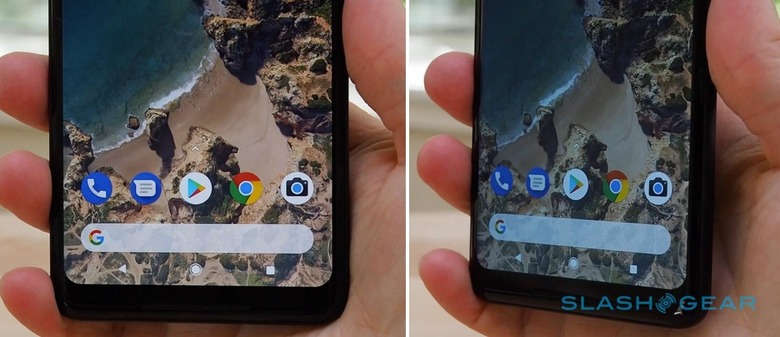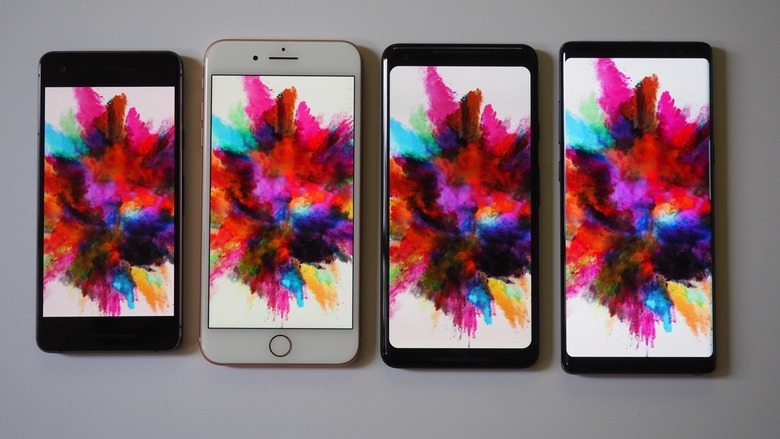Pixel 2 XL Screen Saga Keeps Getting Worse
The Pixel 2 XL is still making headlines, but not for the reasons Google was hoping for. The early wave of generally glowing reviews may have given the Android smartphone a good start, but as devices reach buyers there are big, ominous concerns being raised about Google's choice of display. Right now, there are three big problems the Pixel 2 XL faces, and one awkward question.
Some of the complaints about the Pixel 2 XL could be addressed fairly easily. The earliest criticisms of the OLED screen centered on how it displayed colors, with the phone being more muted than rival devices using the same screen technology.
Google's argument was that, by adopting the sRGB color palette, developers using the Pixel 2 XL to test their apps would have a better sense of how they'd look when fully deployed. Maybe so, was the response, but even with the "Vivid" color toggle switched on, the phone looked drab and underwhelming next to OLED and LCD phones.

As a follow-up, Google suggested that it would monitor the reactions and might push out a software update. The expectation is that such an update would include a wider range of color settings, much as Samsung offers a selection on its recent Galaxy line-up. That way, Pixel 2 owners could choose whether they wanted realistic colors or more eye-pleasing saturation.
So far so good, but not everything can be fixed with firmware. At the same time as the OLED's punchiness was being discussed, questions about blue shift were also being raised. Tilt the Pixel 2 XL from left to right, or look at its screen from above or below, and there's a noticeable blue cast.
It's most obvious when you're looking at something with a white background, like simple text on a plain page, but it's visible to some extent most of the time you're using the phone. How annoying it is seemingly depends on the individual: some people say they can't see anything but the blue hue, while others are less affected.

Unfortunately, blue shift isn't something you can address with software, it's an inherent property of the display panel itself. That in and of itself is reason enough to check out a Pixel 2 XL in a Verizon store in-person if you can, before you order (and even if you opt to order online instead). Only your eyes will be able to decide whether it's a deal-breaker.
The biggest, and arguably most concerning, issue, though, is screen burn-in. It's something we used to see with reasonable frequency back in the early days of OLED's commercialization, though in recent years and as the display technology improves, it's grown less common.
Basically, as the name suggests, OLED burn-in is when some of the pixels get "stuck" on what they were previously displaying. It's most likely to occur in areas where the UI is unchanging: the notification bar, for instance, and the persistent buttons along the bottom of the display are the most common areas. How noticeable it is can vary, from the very mildest of ghosting that only shows against a certain color background, to something a lot more obvious.
While there are apps and tools which claim to "fix" OLED burn-in, in reality if your smartphone is showing it there's not much you can do to address it bar replace the handset. What's worrying is that this is very, very early for a brand new device to start displaying burn-in, given how short a period the Pixel 2 XL has been available.

Now, not every user is reporting it, but for those who are it seems a replacement under warranty is Google's strategy. That's all well and good, but there's no telling whether those replacement phones will themselves exhibit the same problems. If the burn-in becomes more widespread, Google faces a tough decision: keep replacing under warranty, or have a recall as it changes the OLED panel itself.
With all this said, can I still recommend the Pixel 2 XL? There's no denying that, as I said in our review, it has an incredible camera and the build quality is high. Battery life is good, and there's certainly value to being at the cutting-edge of Google's Android release cycle.
For the moment, with Google doing the right thing with warranty replacements, I can't blame you for jumping on the Pixel 2 XL. While I'd still recommend checking out the muted colors and blue shifting display in person before you whip out your credit card, if you're one of the unlucky folks who goes on to experience OLED burn-in it appears Google has your back.
MORE Pixel 2 XL screen vs iPhone 8 Plus / LG V30 / Note 8
All the same, the smartphone landscape is competitive and there are plenty of alternative choices out there which don't have this uncertainty hanging over them. On the Android side, Samsung's Galaxy S8 and Note 8 remain more than solid picks. Apple's iPhone 8 and iPhone 8 Plus may use LCD – the upcoming iPhone X gets an OLED panel – but they're color-rich and basically at the top of their game. Whichever you go for, you're getting great photography talents, too.
The sensible route, if you can't resist a Pixel 2 XL but have the patience to wait, is to see just what happens over the next couple of weeks. With complaints about the phone showing no signs of dying down by themselves, Google is going to have to make a decision about the fate of the Pixel 2 XL sooner rather than later. The wisest consumer will probably hold off until that decision comes
